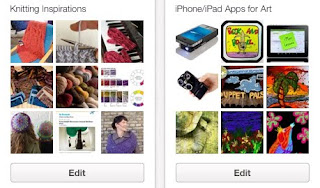As a visual learner, I can still remember when the Internet and the web first were developing. One of the biggest disappointments and early realizations of those who design was that the web was this wonderfully powerful tool that in its beginning was all text and no images. Slow dial up Internet really limited the quality and amount of images that were able to be displayed on a page...seems like ancient history, but the web used to be mostly words and hyperlinked text. Fast forward to the 21st century and here we are in a bombardment of visual imagery all streaming to us at speeds unimaginable and we can hold this information in the palm of our hands if we want too, AMAZING. It is to this end that I eagerly subscribed to
Pinterest, the ultimate tool for the visual learner.
Pinterest enables its users to pin images and video to an online board, kind of like your bulletin board. The boards are set up by the user in any number of categories. There are preset categories you can choose or you can make your own. You can invite friends to join Pinterest and you can also make follow people the way you follow on
Twitter. You can also make your boards into group boards by inviting others to join the board. This collaborative aspect of Pinterest is the most appealing to me as an art educator. Pooling your thoughts and the images you find and sharing them with each other could be a very powerful teaching tool. You can add a written description of your pin complete with links and any other information you wish to share. This adds to the level of value. The pins and boards can be simply visual or they can go farther with words and links.
I have played with Pinterest mostly as my own toy...collecting inspiring knitting designs and joining one group board about iPad and iPod apps. I have sung the praises of my personal learning network in the past on this blog and Pinterest is just one more way I can connect with the PLN. I am following a lot of the same talented art educators whom I already follow on
Twitter and on
Art Ed 2.0 ning network. I don't own an iPhone or iPod yet, but hope to get one for Christmas. I have learned so much about the many art related apps from this pin group. What I like about this shared board is that the teachers pinning do a nice job of describing their pins so you get more than just a picture.
There are many ways to capture your web content and save it. First there was the idea of Bookmarking sites, which resided on a single computer, then came
Diigo and
Delicious, which enable the user to bookmark and see their library of Bookmarks anywhere. Then came
livebinders, which has you collecting web content into digital binders and adding images and words to the binders if you choose. Each of these are powerful, but the websites often change their content and the exact image that had drawn you in may not be there the next time you visit the site. Pinterest allows you to pin that actual image to your board and keep it as inspiration. As a visual person it is often the image, the colors, the light and shadow that have pulled me to the page, not so much the written content. Pinterest celebrates this type of person and how we think...visually.
As an educator I'd love to have my students start using Pinterest, but several things stand in the way. The first is the inability to make your pins and boards private. I would like to be able to set up a class group for my students where we could collaborate individually as a class and only the student members of the class would be able to see the content pinned and discussed there.
Diigo has done a fabulous job of offering an Educator version of their site and I wish and hope that Pinterest will do the same some day. Currently the other big thing holding my students back from using this is that they are not allowed to download and install anything to their laptops. This means that they can't install the easy to use
Pin It button. This button is what allows you to pin anything you find on any site. Without it, the whole interface doesn't work. I am hoping the IT department will consider installing it for us...we'll see.
Have fun with Pinterest...but beware. One other thing I noticed is that it is pretty easy for images to be copied and passed around with Pinterest...that's the point of it, but it seems pretty easy for people to get images that maybe weren't supposed to be able to be copied. There is a lengthy page about
copyright on Pinterest and they've certainly done their best to discuss this in their
Pin etiquette, but I noticed that I had an image on my own
flickr account that I pinned to a board. Because I can't make my board private, 3 other people re-pinned the image. On my flickr the image is copyright protected and can't be downloaded by others. By my pinning it others can now get it and do what they want with it. Being able to have private boards and pins would resolve this issue. I like that on
Diigo and
Delicious and
Livebinders I can choose to collaborate and share or not....I wish this was an option on Pinterest.
Aside from the privacy thing I think Pinterest is a great tool for the visually inclined person. I collect scraps of fabric, torn out magazine images, my own photos and more into sketchbooks and journals. Pinterest allows you as the artist to continue that practice while you're online. That visual brainstorming is my favorite part of Pinterest and being an artist.










